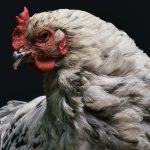Bantam chickens have specific winter care requirements due to their smaller size compared to standard breeds. Their reduced body mass makes them more susceptible to cold temperatures, as they generate and retain less heat. Bantam chickens also have smaller combs and wattles, which are more prone to frostbite.
These vulnerabilities necessitate appropriate protective measures during winter months. Proper nutrition and hydration are crucial for bantam chickens in winter. Cold temperatures increase their energy requirements as they work to maintain body temperature.
A balanced diet and access to clean water are essential for supporting overall health and immune function. Egg production may decrease during winter, so managing expectations and providing appropriate care is important. Understanding and addressing the specific needs of bantam chickens in winter allows owners to take proactive steps in ensuring their comfort and health throughout colder months.
This includes providing adequate shelter, protection from drafts, and appropriate feeding and watering practices tailored to their unique requirements.
Table of Contents
- 1 Providing proper shelter and bedding for bantam chickens
- 2 Using supplemental heat sources for bantam chickens
- 3 Ensuring adequate ventilation while keeping bantam chickens warm
- 4 Feeding and watering bantam chickens during the winter months
- 5 Protecting bantam chickens from frostbite and other winter hazards
- 6 Monitoring the health and well-being of bantam chickens in cold weather
- 7 FAQs
Key Takeaways
- Bantam chickens need extra care in winter due to their small size and susceptibility to cold temperatures
- Proper shelter and bedding, such as straw or wood shavings, are essential for keeping bantam chickens warm and dry
- Supplemental heat sources like heat lamps or heated pads can help maintain a comfortable temperature for bantam chickens
- Adequate ventilation is crucial to prevent moisture buildup and maintain air quality in the coop
- Providing high-quality, high-energy feed and ensuring access to unfrozen water is vital for bantam chickens’ health and well-being in winter
Providing proper shelter and bedding for bantam chickens
Shelter Requirements
When it comes to shelter, a well-ventilated but draft-free coop is crucial for bantam chickens. The coop should be insulated to provide protection from the cold, but it’s important to ensure that there is adequate ventilation to prevent moisture buildup, which can lead to respiratory issues.
Predator-Proofing and Bedding
Additionally, the coop should be predator-proof to keep your bantam chickens safe from potential threats during the winter months. Bedding is another critical component of providing proper shelter for bantam chickens in winter. Deep litter bedding, such as straw or pine shavings, can provide insulation and warmth for your flock.
Maintenance and Nesting Boxes
It’s important to regularly clean and replace the bedding to prevent moisture buildup and maintain a healthy environment for your bantam chickens. Providing nesting boxes with clean, dry bedding is also essential for bantam chickens to lay eggs comfortably during the winter. By ensuring proper shelter and bedding for your bantam chickens, you can create a safe and cozy environment for them to thrive in despite the cold weather.
Using supplemental heat sources for bantam chickens

In some cases, supplemental heat sources may be necessary to keep bantam chickens warm during particularly harsh winter conditions. While bantam chickens are generally hardy and can tolerate cold temperatures, extreme cold spells can put them at risk. If you live in an area with severe winters, providing supplemental heat in the coop can help prevent frostbite and keep your bantam chickens comfortable.
There are several options for supplemental heat sources, including heat lamps, radiant heaters, and heated pads. It’s important to use caution when using heat lamps, as they can pose a fire hazard if not properly installed and monitored. Radiant heaters and heated pads are safer alternatives that can provide consistent warmth without the risk of fire.
When using supplemental heat sources, it’s crucial to position them safely in the coop, away from flammable materials and out of reach of the bantam chickens. Additionally, it’s important to monitor the temperature in the coop regularly to ensure that it remains within a safe range for your flock. By using supplemental heat sources responsibly, you can help your bantam chickens stay warm and healthy throughout the winter.
Ensuring adequate ventilation while keeping bantam chickens warm
While it’s important to keep bantam chickens warm during the winter, it’s equally crucial to ensure adequate ventilation in the coop. Proper ventilation helps remove moisture and ammonia from the air, which can build up in a confined space and lead to respiratory issues for your flock. Additionally, good ventilation helps regulate the temperature in the coop, preventing it from becoming too stuffy or humid.
To ensure adequate ventilation while keeping bantam chickens warm, it’s important to strike a balance between airflow and insulation. This can be achieved by providing adjustable vents or windows that can be opened or closed as needed to control airflow. It’s also essential to position vents or windows strategically to prevent drafts while still allowing fresh air to circulate.
Regularly cleaning the coop and removing soiled bedding can also help maintain good air quality for your bantam chickens. By prioritizing ventilation alongside warmth, you can create a healthy environment for your flock to thrive in during the winter months.
Feeding and watering bantam chickens during the winter months
Proper nutrition and hydration are essential for bantam chickens to stay healthy and maintain their body temperature during the winter months. Cold temperatures can increase their energy requirements, so it’s important to provide them with a balanced diet that meets their nutritional needs. This may include increasing their protein intake to support their overall health and egg production during the winter.
In addition to a balanced diet, access to clean water is crucial for bantam chickens in winter. It’s important to regularly check their water supply and ensure that it doesn’t freeze in cold temperatures. Using heated waterers or regularly replacing frozen water with fresh, warm water can help prevent dehydration and keep your bantam chickens hydrated throughout the winter.
Additionally, providing warm oatmeal or other treats can help supplement their diet and provide extra energy during particularly cold spells. By prioritizing proper feeding and watering practices, you can support the health and well-being of your bantam chickens during the winter months.
Protecting bantam chickens from frostbite and other winter hazards

Protecting Against Frostbite
To protect your flock from frostbite, it’s important to take proactive measures such as applying petroleum jelly to their combs and wattles to provide a barrier against the cold. Additionally, ensuring proper ventilation and preventing moisture buildup in the coop can help reduce the risk of frostbite for your bantam chickens.
Other Winter Hazards
In addition to frostbite, other winter hazards such as icy conditions and predators pose a threat to bantam chickens. Keeping pathways clear of ice and snow can prevent injuries and make it easier for your flock to move around safely.
Coop Security and Predator Protection
It’s also important to reinforce coop security to protect your bantam chickens from potential predators seeking food in harsh winter conditions. By being proactive in protecting your flock from frostbite and other winter hazards, you can help ensure their safety and well-being throughout the colder months.
Monitoring the health and well-being of bantam chickens in cold weather
Regular monitoring of your bantam chickens’ health and well-being is crucial during the winter months. Cold temperatures can exacerbate existing health issues or make them more susceptible to illness, so it’s important to be vigilant in observing any changes in behavior or appearance. This may include checking for signs of respiratory issues, such as coughing or wheezing, as well as monitoring egg production and overall activity levels.
In addition to physical health, it’s important to consider the mental well-being of your bantam chickens during the winter. Providing enrichment activities such as hanging treats or introducing new toys can help alleviate boredom and reduce stress during periods of confinement due to inclement weather. Regularly spending time with your flock and observing their behavior can also help you identify any potential issues early on.
By staying attentive to the health and well-being of your bantam chickens in cold weather, you can address any concerns promptly and ensure that they receive the care they need to thrive throughout the winter months. In conclusion, understanding the specific needs of bantam chickens in winter is essential for providing them with proper care and ensuring their health and well-being during the colder months. From providing adequate shelter and bedding to managing their nutrition and hydration, there are several key considerations for keeping bantam chickens comfortable in cold weather.
By taking proactive measures such as using supplemental heat sources responsibly, ensuring adequate ventilation, and protecting them from frostbite and other winter hazards, you can create a safe and cozy environment for your flock to thrive in despite the challenges of winter. Regular monitoring of their health and well-being is also crucial for identifying any potential issues early on and providing them with the care they need to stay healthy throughout the colder months. By prioritizing the specific needs of bantam chickens in winter, you can help them weather the season with comfort and resilience.
If you’re looking for more information on keeping chickens warm in winter, you might also be interested in learning about what vegetables quails eat. Check out this article to discover the best vegetables to feed your quails for optimal health and nutrition.
FAQs
What are bantam chickens?
Bantam chickens are small breeds of chickens, typically about one-fourth to one-fifth the size of standard chicken breeds. They are popular for their small size, colorful plumage, and friendly demeanor.
Do bantam chickens need extra warmth in winter?
Yes, bantam chickens may need extra warmth in winter, especially in colder climates. Their small size makes them more susceptible to cold temperatures, so providing them with a warm and cozy environment is important for their well-being.
How can I keep my bantam chickens warm in winter?
You can keep your bantam chickens warm in winter by providing them with a well-insulated coop, using heat lamps or heated pads, and ensuring they have access to fresh water that doesn’t freeze.
What temperature is too cold for bantam chickens?
Bantam chickens can tolerate temperatures as low as 20°F (-6°C), but anything lower than that may be too cold for them. It’s important to monitor the temperature in their coop and take measures to keep it above freezing.
Are there any specific breeds of bantam chickens that are more cold-hardy?
Some bantam chicken breeds, such as the Cochin and the Wyandotte, are known to be more cold-hardy than others. If you live in a colder climate, consider choosing a cold-hardy breed for your bantam chickens.
Meet Walter, the feathered-friend fanatic of Florida! Nestled in the sunshine state, Walter struts through life with his feathered companions, clucking his way to happiness. With a coop that’s fancier than a five-star hotel, he’s the Don Juan of the chicken world. When he’s not teaching his hens to do the cha-cha, you’ll find him in a heated debate with his prized rooster, Sir Clucks-a-Lot. Walter’s poultry passion is no yolk; he’s the sunny-side-up guy you never knew you needed in your flock of friends!







